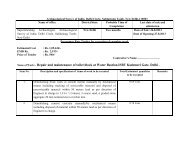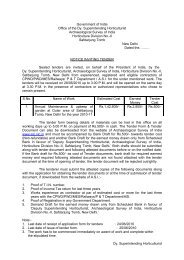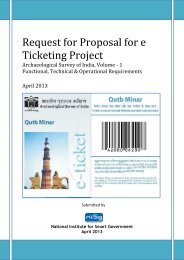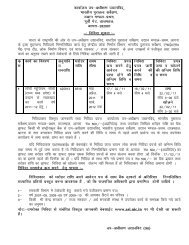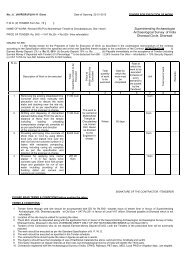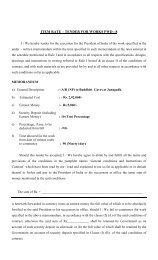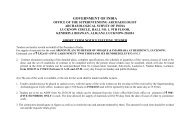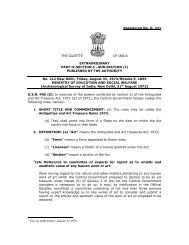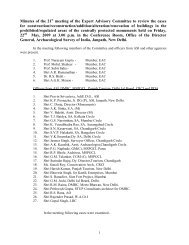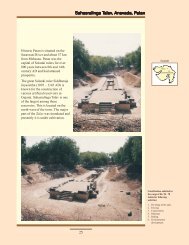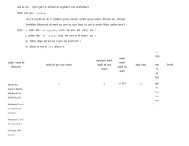the karnataka ancient and historical monuments - Archaeological ...
the karnataka ancient and historical monuments - Archaeological ...
the karnataka ancient and historical monuments - Archaeological ...
Create successful ePaper yourself
Turn your PDF publications into a flip-book with our unique Google optimized e-Paper software.
1<br />
THE KARNATAKA ANCIENT AND HISTORICAL MONUMENTS<br />
AND ARCHAEOLOGICAL SITES AND REMAINS ACT, 1961.<br />
Statement of Objects <strong>and</strong> Reasons:<br />
Sections:<br />
1. Short title, extent <strong>and</strong> commencement.<br />
2. Definitions.<br />
ARRANGEMENT OF SECTIONS<br />
PRELIMINARY<br />
PROTECTED MONUMENTS<br />
3. Ancient <strong>and</strong> Historical <strong>monuments</strong> <strong>and</strong> archaeological sites <strong>and</strong> remains deemed to be<br />
protected <strong>monuments</strong> <strong>and</strong> areas.<br />
4. Power of Government to declare <strong>ancient</strong> <strong>monuments</strong> to be protected <strong>monuments</strong>.<br />
5. Acquisition of rights in a protected monument.<br />
6. Preservation of protected monument by agreement.<br />
7. Owners under disability or not in possession.<br />
8. Application of endowment to repair a protected monument.<br />
9. Failure or refusal to enter into an agreement.<br />
10. Power to make order prohibiting contravention of agreement under section 5.<br />
11. Enforcement of agreements.<br />
12. Purchasers at certain sales <strong>and</strong> persons claiming through owner bound by instrument<br />
executed by owner.<br />
13. Acquisition of protected monument.<br />
14. Maintenance of certain protected <strong>monuments</strong>.<br />
15. Voluntary contributions.<br />
16. Protection of place of worship, from misuse, pollution or desecration.<br />
17. Relinquishment of Government rights in a monument.<br />
18. Right of access to protected <strong>monuments</strong>.<br />
PROTECTED AREAS<br />
19. Power of Government to declare archeological site <strong>and</strong> remains to be protected area.<br />
20. Restrictions on enjoyment of property rights in protected areas.<br />
21. Power to acquire protected areas.<br />
PROTECTION OF ANTIQUITIES<br />
22. Power of Government to control moving of antiquities.<br />
23. Purchase of antiquities by Government.<br />
24. Compensation for loss or damage.<br />
PRINCIPLES OF COMPENSATION<br />
25. Assessment of market value or compensation.<br />
26. Penalties.<br />
27. Jurisdiction to try offences.<br />
28. Certain offences to be cognisable.<br />
MISCELLANEOUS
29. Recovery of amounts due to <strong>the</strong> Government.<br />
30. Protection of action taken under <strong>the</strong> Act.<br />
31. Power to make rules.<br />
32. Repeal <strong>and</strong> savings.<br />
33. Act in addition to <strong>and</strong> not in derogation of Central Act 24 of 1958.<br />
2<br />
* * * *<br />
STATEMENT OF OBJECTS AND REASONS<br />
Act 7 of 1962.- In <strong>the</strong> new State of Mysore, <strong>the</strong> following Acts relating to protection <strong>and</strong><br />
preservation of <strong>ancient</strong> <strong>monuments</strong>, etc., are in force:—<br />
(1) The Hyderabad Ancient Monuments Preservation Act, 1337F (Hyderabad Act VIII of 1337<br />
Fasli) is in force in <strong>the</strong> Hyderabad Area;<br />
(2) The Mysore Ancient Monuments Preservation Act, 1925 (Mysore Act IX of 1925) is in force<br />
in <strong>the</strong> Mysore Area; <strong>and</strong><br />
(3) The Ancient Monuments Preservation Act, 1904 (Central Act VII of 1904) is in force in all<br />
<strong>the</strong> areas of <strong>the</strong> new State of Mysore.<br />
The Government of India have advised <strong>the</strong> State Governments not to take advantage of <strong>the</strong><br />
provisions of <strong>the</strong> aforesaid Central Act to protect <strong>and</strong> preserve <strong>monuments</strong> <strong>and</strong> to enact <strong>the</strong>ir own<br />
laws on <strong>the</strong> subject.<br />
Recently, <strong>the</strong> Government of India have enacted <strong>the</strong> Ancient Monuments <strong>and</strong> <strong>Archaeological</strong><br />
Sites <strong>and</strong> Remains Act, 1958 covering matters falling under entry 67 in <strong>the</strong> Union List <strong>and</strong> entry<br />
40 in Concurrent List of <strong>the</strong> Seventh Schedule to <strong>the</strong> Constitution of India.<br />
The present Bill seeks to bring about uniformity in <strong>the</strong> laws relating to protection <strong>and</strong><br />
preservation of <strong>ancient</strong> <strong>monuments</strong> falling under entry 12 in <strong>the</strong> State List, that is, <strong>ancient</strong> <strong>and</strong><br />
<strong>historical</strong> <strong>monuments</strong> o<strong>the</strong>r than those declared by or under law made by Parliament to be of<br />
national importance.<br />
The provisions of <strong>the</strong> Bill are on <strong>the</strong> lines of <strong>the</strong> corresponding provisions of <strong>the</strong> Ancient<br />
Monuments <strong>and</strong> <strong>Archaeological</strong> Sites <strong>and</strong> Remains Act, 1958.<br />
(Obtained from File No. LAW 81 LGN 58).
3<br />
1<br />
[KARNATAKA ACT] 1<br />
No. 7 OF 1962<br />
(First published in <strong>the</strong> 1<br />
[Karnataka Gazette] 1<br />
on <strong>the</strong> Fifteenth day of February, 1961.)<br />
THE 1<br />
[KARNATAKA] 1<br />
ANCIENT AND HISTORICAL MONUMENTS AND<br />
ARCHÆOLOGICAL SITES AND REMAINS ACT, 1961.<br />
(Received <strong>the</strong> assent of <strong>the</strong> President on <strong>the</strong> Fourth day of February, 1962.)<br />
An Act to provide for <strong>the</strong> preservation of <strong>ancient</strong> <strong>and</strong> <strong>historical</strong> <strong>monuments</strong> <strong>and</strong><br />
Archeological sites <strong>and</strong> remains <strong>and</strong> for <strong>the</strong> protection of sculptures, carvings <strong>and</strong> o<strong>the</strong>r<br />
like objects in <strong>the</strong> 1 [State of Karnataka] 1 .<br />
WHEREAS it is expedient to provide for <strong>the</strong> preservation of <strong>ancient</strong> <strong>and</strong> <strong>historical</strong><br />
<strong>monuments</strong> <strong>and</strong> archeological sites <strong>and</strong> remains in <strong>the</strong> 1 [State of Karnataka] 1 o<strong>the</strong>r than<br />
those declared by or under law made by Parliament to be of national importance, <strong>and</strong> for<br />
<strong>the</strong> protection of sculptures, carvings <strong>and</strong> o<strong>the</strong>r like objects;<br />
BE it enacted by <strong>the</strong> 1 [Karnataka State] 1 Legislature in <strong>the</strong> Twelfth Year of <strong>the</strong><br />
Republic of India as follows:—<br />
1. Adapted by <strong>the</strong> Karnataka Adaptations of Laws Order, 1973 w.e.f. 01.11.1973.<br />
PRELIMINARY<br />
1. Short title, extent <strong>and</strong> commencement.—(1) This Act may be called <strong>the</strong><br />
1 1 [Karnataka] Ancient <strong>and</strong> Historical Monuments <strong>and</strong> Archeological Sites <strong>and</strong> Remains<br />
Act, 1961.<br />
1. Adapted by <strong>the</strong> Karnataka Adaptations of Laws Order, 1973 w.e.f. 01.11.1973.<br />
(2) It extends to <strong>the</strong> whole of <strong>the</strong> 1 [State of Karnataka] 1 .<br />
(3) It shall come into force on such 2 [date] 2 as <strong>the</strong> Government may, by notification in<br />
<strong>the</strong> official Gazette, appoint.<br />
1. Adapted by <strong>the</strong> Karnataka Adaptations of Laws Order, 1973 w.e.f. 01.11.1973.<br />
2. Act has come into force w.e.f. 15.08.1966 by notification No. ED 16 SAR 64 dated 8.8.66.<br />
2. Definitions.—In this Act, unless <strong>the</strong> context o<strong>the</strong>rwise requires,—<br />
(1) “<strong>ancient</strong> monument” means any structure, erection or monument, or any tumulus<br />
or place of interment, or any cave, rock-sculpture, inscription or monolith, which is of<br />
<strong>historical</strong>, archeological or artistic interest <strong>and</strong> which has been in existence for not less<br />
than one hundred years, <strong>and</strong> includes,—<br />
(i) <strong>the</strong> remains of an <strong>ancient</strong> monument,<br />
(ii) <strong>the</strong> site of an <strong>ancient</strong> monument,<br />
(iii) such portion of l<strong>and</strong> adjoining <strong>the</strong> site of an <strong>ancient</strong> monument as may be<br />
required for fencing or covering in or o<strong>the</strong>rwise preserving such monument,<br />
<strong>and</strong><br />
(iv) <strong>the</strong> means of access to, <strong>and</strong> convenient inspection of, an <strong>ancient</strong> monument;<br />
-but shall not include <strong>ancient</strong> <strong>and</strong> <strong>historical</strong> <strong>monuments</strong> declared by or under law made<br />
by Parliament to be of national importance;<br />
(2) “antiquity” includes,-<br />
(i) any coin, sculpture, manuscript, epigraph, or o<strong>the</strong>r work of art or craftsmanship,<br />
(ii) any article, object or thing detached from a building or cave,<br />
(iii) any article, object or thing illustrative of science, art, crafts, literature, religion,<br />
customs or morals in bygone ages,
(iv) any article, object or thing of <strong>historical</strong> interest, <strong>and</strong><br />
4<br />
(v) any article, object or thing declared by <strong>the</strong> Government by notification in <strong>the</strong><br />
official Gazette, to be an antiquity for <strong>the</strong> purposes of this Act,<br />
-which has been in existence for not less than one hundred years;<br />
(3) “archeological site <strong>and</strong> remains” means any area which contains or is<br />
reasonably believed to contain ruins or relics of <strong>historical</strong> or archeological importance<br />
which have been in existence for not less than one hundred years, <strong>and</strong> includes,-<br />
(i) such portion of l<strong>and</strong> adjoining <strong>the</strong> area as may be required for fencing or<br />
covering in or o<strong>the</strong>rwise preserving it, <strong>and</strong><br />
(ii) <strong>the</strong> means of access to, <strong>and</strong> convenient inspection of, <strong>the</strong> area;<br />
(4) “Director” means <strong>the</strong> Director of Archeology, <strong>and</strong> includes any officer<br />
authorised by <strong>the</strong> Government to perform <strong>the</strong> duties of <strong>the</strong> Director;<br />
(5) “Government” means <strong>the</strong> State Government;<br />
(6) “maintain” with its grammatical variations <strong>and</strong> cognate expressions, includes<br />
<strong>the</strong> fencing, covering in, repairing, restoring <strong>and</strong> cleansing of a protected monument, <strong>and</strong><br />
<strong>the</strong> doing of any act which may be necessary for <strong>the</strong> purpose of preserving a protected<br />
monument or of securing convenient access <strong>the</strong>reto;<br />
(7) “owner” includes,-<br />
(i) a joint owner invested with powers of management on behalf of himself<br />
<strong>and</strong> o<strong>the</strong>r joint owners, <strong>and</strong> <strong>the</strong> successor-in-title of any such owner; <strong>and</strong><br />
(ii) any manager or trustee exercising powers of management <strong>and</strong> <strong>the</strong><br />
successor-in-office of any such manager or trustee;<br />
(8) “prescribed” means prescribed by rules made under this Act;<br />
(9) “protected area” means any archeological site <strong>and</strong> remains which is declared<br />
to be protected under this Act;<br />
(10) “protected monument” means an <strong>ancient</strong> monument which is declared to be<br />
protected by or under this Act.<br />
PROTECTED MONUMENTS<br />
3. Ancient <strong>and</strong> <strong>historical</strong> <strong>monuments</strong> <strong>and</strong> archeological sites <strong>and</strong> remains<br />
deemed to be protected <strong>monuments</strong> <strong>and</strong> areas.—All <strong>ancient</strong> <strong>and</strong> <strong>historical</strong><br />
<strong>monuments</strong> <strong>and</strong> all archeological sites <strong>and</strong> remains which have been declared by <strong>the</strong><br />
Ancient Monuments Preservation Act, 1904 (Central Act VII of 1904), or <strong>the</strong> Ancient<br />
Monuments Preservation Act, 1337 F (Hyderabad Act VIII of 1337 Fasli) or <strong>the</strong> Mysore<br />
Ancient Monuments Preservation Act, 1925 (Mysore Act IX of 1925), to be protected<br />
<strong>monuments</strong> but which have not been declared by or under law made by Parliament to be<br />
of national importance, shall be deemed to be <strong>ancient</strong> <strong>and</strong> <strong>historical</strong> <strong>monuments</strong> or<br />
archeological sites <strong>and</strong> remains declared to be protected <strong>monuments</strong> or protected areas,<br />
as <strong>the</strong> case may be, under this Act.<br />
4. Power of Government to declare <strong>ancient</strong> <strong>monuments</strong> to be protected<br />
<strong>monuments</strong>.—(1) Where <strong>the</strong> Government is of opinion that any <strong>ancient</strong> monument<br />
should be declared as a protected monument, it may, by notification in <strong>the</strong> official<br />
Gazette, give two months’ notice of its intention to declare such <strong>ancient</strong> monument to be
5<br />
a protected monument <strong>and</strong> a copy of every such notification shall be affixed in a<br />
conspicuous place near <strong>the</strong> monument.<br />
(2) Any person interested in any such <strong>ancient</strong> monument may within two months after<br />
<strong>the</strong> issue of <strong>the</strong> notification, object to <strong>the</strong> declaration of <strong>the</strong> monument to be a protected<br />
monument.<br />
(3) On <strong>the</strong> expiry of <strong>the</strong> said period of two months, <strong>the</strong> Government may, after<br />
considering <strong>the</strong> objections, if any, received by it, declare by notification in <strong>the</strong> official<br />
Gazette <strong>the</strong> <strong>ancient</strong> monument to be a protected monument.<br />
(4) A notification published under sub-section (3) shall, unless <strong>and</strong> until it is<br />
withdrawn, be conclusive evidence of <strong>the</strong> fact that <strong>the</strong> <strong>ancient</strong> monument to which it<br />
relates is a protected monument for <strong>the</strong> purposes of this Act.<br />
5. Acquisition of rights in a protected monument.—(1) The Director may, with <strong>the</strong><br />
sanction of <strong>the</strong> Government, purchase or take a lease of, or accept a gift or bequest of,<br />
any protected monument.<br />
(2) Where a protected monument is without an owner, <strong>the</strong> Director may by notification<br />
in <strong>the</strong> official Gazette, assume <strong>the</strong> guardianship of <strong>the</strong> monument.<br />
(3) The owner of any protected monument may, by written instrument, constitute <strong>the</strong><br />
Director as <strong>the</strong> guardian of <strong>the</strong> monument, <strong>and</strong> <strong>the</strong> Director may, with <strong>the</strong> sanction of <strong>the</strong><br />
Government, accept such guardianship.<br />
(4) When <strong>the</strong> Director has accepted <strong>the</strong> guardianship of a monument under subsection<br />
(3), <strong>the</strong> owner shall, except as expressly provided in this Act, have <strong>the</strong> same<br />
estate, right, title <strong>and</strong> interest in <strong>and</strong> to <strong>the</strong> monument as if <strong>the</strong> Director had not been<br />
constituted a guardian <strong>the</strong>reof.<br />
(5) When <strong>the</strong> Director has accepted <strong>the</strong> guardianship of a monument under subsection<br />
(3), <strong>the</strong> provisions of this Act relating to agreements executed under section 6<br />
shall apply to <strong>the</strong> written instrument executed under <strong>the</strong> said sub-section.<br />
(6) Nothing in this section shall affect <strong>the</strong> use of any protected monument for<br />
customary religious observances.<br />
6. Preservation of protected monument by agreement.—(1) The Deputy<br />
Commissioner when so directed by <strong>the</strong> Government, shall propose to <strong>the</strong> owner of a<br />
protected monument to enter into an agreement with <strong>the</strong> Government within a specified<br />
period for <strong>the</strong> maintenance of <strong>the</strong> monument.<br />
(2) An agreement under this section may provide for all or any of <strong>the</strong> following<br />
matters, namely:—<br />
(a) <strong>the</strong> maintenance of <strong>the</strong> monument;<br />
(b) <strong>the</strong> custody of <strong>the</strong> monument <strong>and</strong> <strong>the</strong> duties of any person who may be<br />
employed to watch it;<br />
(c) <strong>the</strong> restriction of <strong>the</strong> owner’s right,-<br />
(i)to use <strong>the</strong> monument for any purpose,<br />
(ii)to charge any fee for entry into, or inspection of, <strong>the</strong> monument,<br />
(iii)to destroy, remove, alter or deface <strong>the</strong> monument, or<br />
(iv)to build on or near <strong>the</strong> site of <strong>the</strong> monument;
6<br />
(d) <strong>the</strong> facilities of access to be permitted to <strong>the</strong> public or any section <strong>the</strong>reof or to<br />
any officer of <strong>the</strong> Department of Archeology or to persons deputed by <strong>the</strong> Director or <strong>the</strong><br />
Deputy Commissioner or <strong>the</strong> owner to inspect or maintain <strong>the</strong> monument;<br />
(e) <strong>the</strong> notice to be given to <strong>the</strong> Government in case <strong>the</strong> l<strong>and</strong> on which <strong>the</strong><br />
monument is situated or any adjoining l<strong>and</strong> is offered for sale by <strong>the</strong> owner, <strong>and</strong> <strong>the</strong> right<br />
to be reserved to <strong>the</strong> Government to purchase such l<strong>and</strong>, or any specified portion of<br />
such l<strong>and</strong>, at it's market value;<br />
(f) <strong>the</strong> payment of any expenses incurred by <strong>the</strong> owner or by <strong>the</strong> Government in<br />
connection with <strong>the</strong> maintenance of <strong>the</strong> monument;<br />
(g) <strong>the</strong> proprietary or o<strong>the</strong>r rights which are to vest in <strong>the</strong> Government in respect<br />
of <strong>the</strong> monument when any expenses are incurred by <strong>the</strong> Government in connection with<br />
<strong>the</strong> maintenance of <strong>the</strong> monument;<br />
(h) <strong>the</strong> appointment of an authority to decide any dispute arising out of <strong>the</strong><br />
agreement; <strong>and</strong><br />
(i) any matter connected with <strong>the</strong> maintenance of <strong>the</strong> monument which is a<br />
proper subject of agreement between <strong>the</strong> owner <strong>and</strong> <strong>the</strong> Government.<br />
(3) The Government or <strong>the</strong> owner may, at any time after <strong>the</strong> expiration of three years<br />
from <strong>the</strong> date of execution of an agreement under this section, terminate it on giving six<br />
months’ notice in writing to <strong>the</strong> o<strong>the</strong>r party:<br />
Provided that <strong>the</strong> owner shall pay to <strong>the</strong> Government <strong>the</strong> expenses, if any, incurred<br />
by it on <strong>the</strong> maintenance of <strong>the</strong> monument during <strong>the</strong> five years immediately preceding<br />
<strong>the</strong> termination of <strong>the</strong> agreement, in <strong>the</strong> case of an agreement which has been in force<br />
for more than five years, or, if <strong>the</strong> agreement has been in force for not more than five<br />
years during <strong>the</strong> period <strong>the</strong> agreement was in force.<br />
(4) An agreement under this section shall be binding on any person claiming to be<br />
owner of <strong>the</strong> monument to which it relates from, through or under a party by whom or on<br />
whose behalf <strong>the</strong> agreement was executed.<br />
7. Owners under disability or not in possession.—(1) If <strong>the</strong> owner of a protected<br />
monument is unable, by reason of infancy or any o<strong>the</strong>r disability, to act for himself, <strong>the</strong><br />
person legally competent to act on his behalf may exercise <strong>the</strong> powers conferred upon<br />
an owner by section 6.<br />
(2) In <strong>the</strong> case of village property, <strong>the</strong> village officer or any o<strong>the</strong>r person exercising<br />
powers of management over such property may exercise <strong>the</strong> powers conferred upon an<br />
owner by section 6.<br />
(3) Nothing in this section shall be deemed to empower any person not being of <strong>the</strong><br />
same religion as <strong>the</strong> person on whose behalf he is acting to make or execute an<br />
agreement relating to a protected monument which or any part of which is periodically<br />
used for <strong>the</strong> religious worship or observances of that religion.<br />
8. Application of endowment to repair a protected monument.—(1) If any owner<br />
or o<strong>the</strong>r person competent to enter into an agreement under section 6 for <strong>the</strong><br />
maintenance of a protected monument refuses or fails to enter into such an agreement,<br />
<strong>and</strong> if any endowment has been created for <strong>the</strong> purpose of keeping such monument in<br />
repair or for that purpose among o<strong>the</strong>rs, <strong>the</strong> Government may institute a suit in <strong>the</strong> Court<br />
of <strong>the</strong> District Judge, or, if <strong>the</strong> estimated cost of repairing <strong>the</strong> monument does not
7<br />
exceed one thous<strong>and</strong> rupees, may make an application to <strong>the</strong> District Judge for <strong>the</strong><br />
proper application of such endowment or part <strong>the</strong>reof.<br />
(2) On <strong>the</strong> hearing of an application under sub-section (1), <strong>the</strong> District Judge may<br />
summon <strong>and</strong> examine <strong>the</strong> owner <strong>and</strong> any person whose evidence appears to him<br />
necessary <strong>and</strong> may pass an order for <strong>the</strong> proper application of <strong>the</strong> endowment or of any<br />
part <strong>the</strong>reof, <strong>and</strong> any such order may be executed as if it were a decree of a civil court.<br />
9. Failure or refusal to enter into an agreement.—(1) If any owner or o<strong>the</strong>r person<br />
competent to enter into an agreement under section 6 for <strong>the</strong> maintenance of a<br />
protected monument refuses or fails to enter into such agreement, <strong>the</strong> Government may<br />
make an order providing for all or any of <strong>the</strong> matters specified in sub-section (2) of<br />
section 6, <strong>and</strong> such order shall be binding on <strong>the</strong> owner or such o<strong>the</strong>r person <strong>and</strong> on<br />
every person claiming title to <strong>the</strong> monument from, through or under, <strong>the</strong> owner or such<br />
o<strong>the</strong>r person.<br />
(2) Where an order made under sub-section (1) provides that <strong>the</strong> monument shall be<br />
maintained by <strong>the</strong> owner or o<strong>the</strong>r person competent to enter into an agreement, all<br />
reasonable expenses for <strong>the</strong> maintenance of <strong>the</strong> monument shall be payable by <strong>the</strong><br />
Government,<br />
(3) No order under sub-section (1), shall be made unless <strong>the</strong> owner or o<strong>the</strong>r person<br />
has been given a reasonable opportunity of making a representation in writing against<br />
<strong>the</strong> proposed order.<br />
10. Power to make order prohibiting contravention of agreement under section<br />
6.—(1) If <strong>the</strong> Director apprehends that <strong>the</strong> owner or occupier of a protected monument<br />
intends to destroy, remove, alter, deface, imperil or misuse <strong>the</strong> monument or to build on<br />
or near <strong>the</strong> site <strong>the</strong>reof in contravention of <strong>the</strong> terms of an agreement under section 6,<br />
<strong>the</strong> Director may after giving <strong>the</strong> owner or occupier a reasonable opportunity of making a<br />
representation in writing, make an order prohibiting any such contravention of <strong>the</strong><br />
agreement:<br />
Provided that no such opportunity may be given in any case where <strong>the</strong> Director for<br />
reasons to be recorded, is satisfied that it is not expedient or practicable to do so.<br />
(2) Any person aggrieved by an order under this section may appeal to <strong>the</strong><br />
Government within such time <strong>and</strong> in such manner as may be prescribed <strong>and</strong> <strong>the</strong><br />
decision of <strong>the</strong> Government shall be final.<br />
11. Enforcement of agreements.—(1) If an owner or o<strong>the</strong>r person who is bound by<br />
an agreement for <strong>the</strong> maintenance of a monument under section 6 refuses or fails within<br />
such reasonable time as <strong>the</strong> Director may fix, to do any act which, in <strong>the</strong> opinion of <strong>the</strong><br />
Director is necessary for <strong>the</strong> maintenance of <strong>the</strong> monument, <strong>the</strong> Director may authorise<br />
any person to do any such act <strong>and</strong> <strong>the</strong> owner or o<strong>the</strong>r person shall be liable to pay <strong>the</strong><br />
expenses of doing any such act or such portion of <strong>the</strong> expenses as <strong>the</strong> owner may be<br />
liable to pay under <strong>the</strong> agreement.<br />
(2) If any dispute arises regarding <strong>the</strong> amount of expenses payable by <strong>the</strong> owner or<br />
o<strong>the</strong>r person under sub-section (1), it shall be referred to <strong>the</strong> Government whose<br />
decision shall be final.<br />
12. Purchasers at certain sales <strong>and</strong> persons claiming through owner bound by<br />
instrument executed by owner.—Every person who purchases, at a sale for arrears of<br />
l<strong>and</strong> revenue or any o<strong>the</strong>r public dem<strong>and</strong>, any l<strong>and</strong> on which is situated a monument in
8<br />
respect of which any instrument has been executed by <strong>the</strong> owner for <strong>the</strong> time being<br />
under section 5 or section 6, <strong>and</strong> every person claiming any title to a monument from,<br />
through or under, an owner who executed any such instrument, shall be bound by such<br />
instrument.<br />
13. Acquisition of protected monument.—If <strong>the</strong> Government apprehends that a<br />
protected monument is in danger of being destroyed, injured, misused, or allowed to fall<br />
into decay, it may acquire <strong>the</strong> protected monument under <strong>the</strong> provisions of <strong>the</strong> L<strong>and</strong><br />
Acquisition Act, 1894, as if <strong>the</strong> maintenance of <strong>the</strong> protected monument were a public<br />
purpose within <strong>the</strong> meaning of that Act.<br />
14. Maintenance of certain protected <strong>monuments</strong>.—(1) The Government shall<br />
maintain every monument which has been acquired under section 13 or in respect of<br />
which any of <strong>the</strong> rights mentioned in section 5 have been acquired.<br />
(2) When <strong>the</strong> Director has accepted <strong>the</strong> guardianship of a monument under section 5,<br />
he shall for <strong>the</strong> purpose of maintaining such monument, have access to <strong>the</strong> monument<br />
at all reasonable times, by himself <strong>and</strong> by his agents, subordinates <strong>and</strong> workmen, for <strong>the</strong><br />
purpose of inspecting <strong>the</strong> monument <strong>and</strong> for <strong>the</strong> purpose of bringing such materials <strong>and</strong><br />
doing such acts as he may consider necessary or desirable for <strong>the</strong> maintenance <strong>the</strong>reof.<br />
15. Voluntary contributions.—The Director may receive voluntary contributions<br />
towards <strong>the</strong> cost of maintaining a protected monument <strong>and</strong> may give orders as to <strong>the</strong><br />
management <strong>and</strong> application of any funds so received by him:<br />
Provided that no contribution received under this section shall be applied to any<br />
purpose o<strong>the</strong>r than <strong>the</strong> purpose for which it was contributed.<br />
16. Protection of place of worship from misuse, pollution or desecration.—(1) A<br />
protected monument maintained by <strong>the</strong> Government under this Act which is a place of<br />
worship or shrine shall not be used for any purpose inconsistent with its character.<br />
(2) Where <strong>the</strong> Government has acquired a protected monument under section 13, or<br />
where <strong>the</strong> Director has, purchased or taken a lease or accepted a gift or bequest, or<br />
assumed guardianship of, a protected monument under section 5, <strong>and</strong> such monument<br />
or any part <strong>the</strong>reof is used for religious worship or observances by any community, <strong>the</strong><br />
Deputy Commissioner shall make due provision for protection of such monument or<br />
such part <strong>the</strong>reof, from pollution or desecration,-<br />
(a) by prohibiting <strong>the</strong> entry <strong>the</strong>rein, except in accordance with conditions prescribed<br />
with <strong>the</strong> concurrence of <strong>the</strong> persons, if any, in religious charge of <strong>the</strong> said monument or<br />
part <strong>the</strong>reof, of any person not entitled so to enter by <strong>the</strong> religious usages of <strong>the</strong><br />
community by which <strong>the</strong> monument or part <strong>the</strong>reof is used, or<br />
(b) by taking such o<strong>the</strong>r action as he may think necessary in this behalf.<br />
17. Relinquishment of Government rights in a monument.—With <strong>the</strong> sanction of<br />
<strong>the</strong> Government, <strong>the</strong> Director may,-<br />
(a) where rights have been acquired by <strong>the</strong> Director in respect of any monument<br />
under this Act by virtue of any sale, lease, gift or will, relinquish, by notification in <strong>the</strong><br />
official Gazette, <strong>the</strong> rights so acquired to <strong>the</strong> person who would for <strong>the</strong> time being be <strong>the</strong><br />
owner of <strong>the</strong> monument if such rights had not been acquired; or<br />
(b) relinquish any guardianship of a monument which he has accepted under this<br />
Act.
9<br />
18. Right of access to protected <strong>monuments</strong>.—Subject to any rules made under<br />
this Act, <strong>the</strong> public shall have a right of access to any protected monument.<br />
PROTECTED AREAS<br />
19. Power of Government to declare archeological site <strong>and</strong> remains to be<br />
protected area.—(1) Where <strong>the</strong> Government is of opinion that any archeological site<br />
<strong>and</strong> remains should be declared as a protected area, it may, by notification in <strong>the</strong> official<br />
gazette, give two months’ notice of its intention to declare such archeological site <strong>and</strong><br />
remains to be a protected area, <strong>and</strong> a copy of every such notification shall be affixed in a<br />
conspicuous place near <strong>the</strong> site <strong>and</strong> remains.<br />
(2) Any person interested in any such archeological site <strong>and</strong> remains may, within two<br />
months after <strong>the</strong> issue of <strong>the</strong> notification, object to <strong>the</strong> declaration of <strong>the</strong> archeological<br />
site <strong>and</strong> remains to be protected area.<br />
(3) On <strong>the</strong> expiry of <strong>the</strong> said period of two months, <strong>the</strong> Government may, after<br />
considering <strong>the</strong> objections, if any, received by it, declare by notification in <strong>the</strong> official<br />
Gazette, <strong>the</strong> archeological site <strong>and</strong> remains to be a protected area.<br />
(4) A notification published under sub-section (3) shall, unless <strong>and</strong> until it is<br />
withdrawn, be conclusive evidence of <strong>the</strong> fact that <strong>the</strong> archeological site <strong>and</strong> remains to<br />
which it relates is a protected area for <strong>the</strong> purposes of this Act.<br />
20. Restrictions on enjoyment of property rights in protected areas.—(1) No<br />
person, including <strong>the</strong> owner or occupier of a protected area, shall construct any building<br />
within <strong>the</strong> protected area or carry on any mining, quarrying, excavating, blasting or any<br />
operation of a like nature in such area, or utilise such area or any part <strong>the</strong>reof in any<br />
o<strong>the</strong>r manner without <strong>the</strong> permission of <strong>the</strong> Government:<br />
Provided that nothing in this sub-section shall be deemed to prohibit <strong>the</strong> use of any<br />
such area or part <strong>the</strong>reof for purposes of cultivation if such cultivation does not involve<br />
<strong>the</strong> digging of not more than one foot of soil from <strong>the</strong> surface.<br />
(2) The Government may, by order, direct that any building constructed by any person<br />
within a protected area in contravention of <strong>the</strong> provisions of sub-section (1) shall be<br />
removed within a specified period <strong>and</strong>, if <strong>the</strong> person refuses or fails to comply with <strong>the</strong><br />
order, <strong>the</strong> Deputy Commissioner may cause <strong>the</strong> building to be removed <strong>and</strong> <strong>the</strong> person<br />
shall be liable to pay <strong>the</strong> cost of such removal.<br />
21. Power to acquire a protected area.—If <strong>the</strong> Government is of opinion that any<br />
protected area contains an <strong>ancient</strong> monument or antiquities of national interest <strong>and</strong><br />
value, it may acquire such area under <strong>the</strong> provisions of <strong>the</strong> L<strong>and</strong> Acquisition Act, 1894,<br />
as if <strong>the</strong> acquisition were for a public purpose within <strong>the</strong> meaning of that Act.<br />
PROTECTION OF ANTIQUITIES<br />
22. Power of Government to control moving of antiquities.—(1) If <strong>the</strong><br />
Government considers that any antiquities or class of antiquities ought not to be moved<br />
from <strong>the</strong> place where <strong>the</strong>y are without <strong>the</strong> sanction of <strong>the</strong> Government, <strong>the</strong> Government<br />
may, by notification in <strong>the</strong> official Gazette, direct that any such antiquity or any class of<br />
such antiquities shall not be moved except with <strong>the</strong> written permission of <strong>the</strong> Director.<br />
(2) Every application for permission under sub-section (1) shall be in such form <strong>and</strong><br />
contain such particulars as may be prescribed.
10<br />
(3) Any person aggrieved by an order refusing permission may appeal to <strong>the</strong><br />
Government whose decision shall be final.<br />
23. Purchase of antiquities by Government.—(1) If <strong>the</strong> Government apprehends<br />
that any antiquity mentioned in a notification issued under sub-section (1) of section 22<br />
is in danger of being destroyed, removed, injured, misused or allowed to fall into decay<br />
or is of opinion that, by reason of its <strong>historical</strong> or archeological importance, it is desirable<br />
to preserve such antiquity in a public place, <strong>the</strong> Government may make an order for <strong>the</strong><br />
compulsory purchase of such antiquity at its market value <strong>and</strong> <strong>the</strong> Deputy Commissioner<br />
shall <strong>the</strong>reupon give notice to <strong>the</strong> owner of <strong>the</strong> antiquity to be purchased.<br />
(2) Where a notice of compulsory purchase is issued under sub-section (1), in respect<br />
of any antiquity, such antiquity shall vest in <strong>the</strong> Government with effect from <strong>the</strong> date of<br />
notice.<br />
(3) The power of compulsory purchase given by this section shall not extend to any<br />
image or symbol actually used for bona fide religious observances.<br />
PRINCIPLES OF COMPENSATION<br />
24. Compensation for loss or damage.—Any owner or occupier of l<strong>and</strong> who has<br />
sustained any loss or damage or any dimunition of profits from <strong>the</strong> l<strong>and</strong> by reason of any<br />
entry on, or excavation in, such l<strong>and</strong>, or <strong>the</strong> exercise of any o<strong>the</strong>r power conferred by<br />
this Act, shall be paid compensation by <strong>the</strong> Government for such loss, damage or<br />
dimunition of profits.<br />
25. Assessment of market value or compensation.—(1) The market value of any<br />
property which <strong>the</strong> Government is empowered to purchase at such value under this Act<br />
or <strong>the</strong> compensation to be paid by <strong>the</strong> Government in respect of anything done under<br />
this Act, shall, where any dispute arises in respect of such market value or<br />
compensation, be ascertained in <strong>the</strong> manner provided in sections 3, 5, 8 to 34, 45, 46,<br />
47, 51 <strong>and</strong> 52 of <strong>the</strong> L<strong>and</strong> Acquisition Act, 1894, in so far as <strong>the</strong>y can be made<br />
applicable:<br />
Provided that, when making an enquiry under <strong>the</strong> said L<strong>and</strong> Acquisition Act, <strong>the</strong><br />
Deputy Commissioner shall be assisted by two assessors one of whom shall be a<br />
competent person nominated by <strong>the</strong> Government <strong>and</strong> one person nominated by <strong>the</strong><br />
owner or, in case <strong>the</strong> owner fails to nominate an assessor within such reasonable time<br />
as may be fixed by <strong>the</strong> Deputy Commissioner in this behalf, by <strong>the</strong> Deputy<br />
Commissioner.<br />
(2) Notwithst<strong>and</strong>ing anything contained in sub-section (1) or in <strong>the</strong> L<strong>and</strong> Acquisition<br />
Act, 1894, in determining <strong>the</strong> market value of any antiquity in respect of which an order<br />
of compulsory purchase is made under sub-section (1) of section 23, any increase in <strong>the</strong><br />
value of <strong>the</strong> antiquity by reason of its being of <strong>historical</strong> or archeological importance shall<br />
not be taken into consideration.<br />
MISCELLANEOUS<br />
26. Penalties.—Whoever,-<br />
(1) (i) destroys, removes, injures, alters, defaces, imperils, or misuses a protected<br />
monument; or<br />
(ii) being <strong>the</strong> owner or occupier of a protected monument, contravenes an order<br />
made under sub-section (1) of section 9 or under sub-section (1) of<br />
section 10; or
11<br />
(iii) removes from a protected monument any sculpture, carving, image, basrelief,<br />
inscription or o<strong>the</strong>r like object;<br />
(iv) does any act in contravention of sub-section (1) of section 20,<br />
-shall be punishable with imprisonment which may extend to three months, or with fine<br />
which may extend to two thous<strong>and</strong> rupees, or with both.<br />
(2) Any person who moves any antiquity in contravention of a notification under subsection<br />
(1) of section 22 shall be punishable with imprisonment which may extend to<br />
three months or fine which may extend to five hundred rupees or with both, <strong>and</strong> <strong>the</strong> court<br />
convicting a person of any such contravention may by order direct that such antiquity<br />
shall be forfeited to Government.<br />
27. Jurisdiction to try offences.—No court inferior to that of a Magistrate of <strong>the</strong> first<br />
class shall try any offence under this Act.<br />
28. Certain offences to be cognizable.—Notwithst<strong>and</strong>ing anything contained in <strong>the</strong><br />
Code of Criminal Procedure, 1898 (Central Act V of 1898), an offence under clause (i) or<br />
clause (iii) of section 26 shall be deemed to be a cognizable offence within <strong>the</strong> meaning<br />
of that Code.<br />
29. Recovery of amounts due to <strong>the</strong> Government.—Any amount due to <strong>the</strong><br />
Government from any person under this Act may, on a certificate issued by <strong>the</strong> Director,<br />
be recovered in <strong>the</strong> same manner as an arrear of l<strong>and</strong> revenue.<br />
30. Protection of action taken under <strong>the</strong> Act.—No suit for compensation <strong>and</strong> no<br />
criminal proceeding shall lie against any public servant in respect of any act done or in<br />
good faith intended to be done in <strong>the</strong> exercise of any power conferred by this Act.<br />
31. Power to make rules.—(1) The Government may, by notification in <strong>the</strong> official<br />
Gazette <strong>and</strong> subject to <strong>the</strong> condition of previous publication, make rules for carrying out<br />
<strong>the</strong> purposes of this Act.<br />
(2) In particular <strong>and</strong> without prejudice to <strong>the</strong> generality of <strong>the</strong> foregoing power, such<br />
rules may provide for all or any of <strong>the</strong> following matters, namely:—<br />
(a) <strong>the</strong> prohibition or regulation by licensing or o<strong>the</strong>rwise of mining, quarrying,<br />
excavating, blasting or any operation of a like nature near a protected monument or <strong>the</strong><br />
construction of buildings on l<strong>and</strong> adjoining such monument <strong>and</strong> <strong>the</strong> removal of<br />
unauthorised buildings;<br />
(b) <strong>the</strong> right of access of <strong>the</strong> public to a protected monument <strong>and</strong> <strong>the</strong> fee, if any, to<br />
be charged <strong>the</strong>refor;<br />
(c) <strong>the</strong> form in which applications for permission under section 20 or section 22<br />
may be made <strong>and</strong> <strong>the</strong> particulars which <strong>the</strong>y should contain;<br />
(d) <strong>the</strong> form <strong>and</strong> manner of preferring appeals under this Act <strong>and</strong> <strong>the</strong> time within<br />
which <strong>the</strong>y may be preferred;<br />
(e) <strong>the</strong> manner of service of any order or notice under this Act;<br />
(f) any o<strong>the</strong>r matter which is to be or may be prescribed.<br />
(3) Any rule made under this section may provide that a breach <strong>the</strong>reof shall be<br />
punishable,—<br />
(i) in <strong>the</strong> case of a rule made with reference to clause (a) of sub-section (2),<br />
with imprisonment which may extend to three months, or with fine which may extend to<br />
two thous<strong>and</strong> rupees, or with both;
12<br />
(ii) in <strong>the</strong> case of a rule made with reference to clause (b) of sub-section (2),<br />
with fine which may extend to five hundred rupees.<br />
(4) Every rule made under this section shall be laid as soon as may be after it is<br />
made, before each House of <strong>the</strong> State Legislature while it is in session for a total period<br />
of thirty days which may be comprised in one session or in two successive sessions, <strong>and</strong><br />
if before <strong>the</strong> expiry of <strong>the</strong> session in which it is so laid or <strong>the</strong> session immediately<br />
following, both Houses agree in making any modification in <strong>the</strong> rule or both Houses<br />
agree that <strong>the</strong> rule should not be made, <strong>the</strong> rule shall <strong>the</strong>reafter have effect only in such<br />
modified form or be of no effect, as <strong>the</strong> case may be; so however that any such<br />
modification or annulment shall be without prejudice to <strong>the</strong> validity of anything previously<br />
done under that rule.<br />
32. Repeal <strong>and</strong> savings.—The Ancient Monuments Preservation Act, 1904 (Central<br />
Act VII of 1904), in so far as it relates to matter covered by Entry 12 of List II of <strong>the</strong><br />
Seventh Schedule to <strong>the</strong> Constitution, <strong>the</strong> Ancient Monuments Preservation Act, 1337 F<br />
(Hyderabad Act VIII of 1337 Fasli), as in force in <strong>the</strong> 1 [Gulbarga Area] 1 , <strong>the</strong> Mysore<br />
Ancient Monuments Preservation Act, 1925 (Mysore Act IX of 1925), as in force in <strong>the</strong><br />
Mysore Area, are hereby repealed:<br />
Provided that <strong>the</strong> provisions of section 6 of <strong>the</strong> 1 [Karnataka] 1 General Clauses Act,<br />
1899 1 [Karnataka] 1 Act III of 1899), shall be applicable in respect of <strong>the</strong> repeal of <strong>the</strong> said<br />
enactments <strong>and</strong> section 24 of <strong>the</strong> said Act shall be applicable as if <strong>the</strong> said enactments<br />
had been repealed <strong>and</strong> re-enacted by this Act.<br />
1. Adapted by <strong>the</strong> Karnataka Adaptations of Laws Order, 1973 w.e.f. 01.11.1973.<br />
33. Act in addition to <strong>and</strong> not in derogation of Central Act 24 of 1958.—The<br />
provisions of this Act shall be in addition to <strong>and</strong> not in derogation of <strong>the</strong> provisions of <strong>the</strong><br />
Ancient Monuments <strong>and</strong> Archeological Sites <strong>and</strong> Remains Act, 1958.<br />
• * * *<br />
NOTIFICATION<br />
Bangalore, dated <strong>the</strong> 8th August 1966 [No. ED 16 SAR 64]<br />
S.O. 5121.- In exercise of <strong>the</strong> powers conferred by sub-section (3) of Section 1 of <strong>the</strong> Mysore<br />
Ancient <strong>and</strong> Historical Monuments <strong>and</strong> <strong>Archaeological</strong> Sites <strong>and</strong> Remains Act, 1961 (Mysore Act<br />
7 of 1962), <strong>the</strong> Government of Mysore hereby appoints <strong>the</strong> 15th August 1966 as <strong>the</strong> date on<br />
which <strong>the</strong> said Act shall come into force.<br />
By Order <strong>and</strong> in <strong>the</strong> name of <strong>the</strong> Governor of Mysore,<br />
(B.R. VERMA)<br />
Secretary.<br />
(Published in <strong>the</strong> Karnataka Gazette (Extraordinary) Part IV-2-C(ii), dated 25th August 1966 at<br />
page. 3045.)<br />
*****




